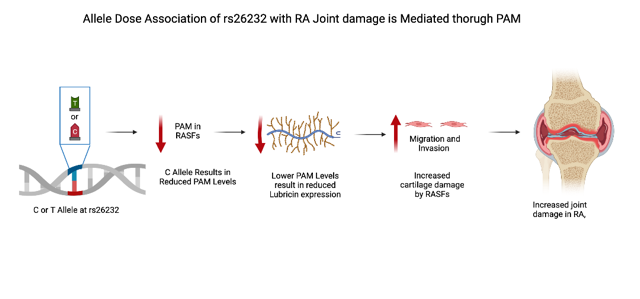Rheumatoid arthritis (RA) is a disease in which the immune system attacks the body and affects around 50,000 people in Ireland. This results in swollen and painful joints, which can be severely debilitating. The underlying cause is a mixture of nature (genetics) and nurture (environment). The genetic site rs26232 has been found to be linked with risk of developing severe joint cartilage damage, dependant on which pair of genetic bases are present (CC, CT or TT). Patients with the bases CC at the rs26232 site have more severe disease than those with CT, with lowest damage in TT. Rheumatoid arthritis synovial fibroblasts (RASFs), cells found in the lining of joints in arthritic patients, are more destructive when they have the CC gene code. To investigate how rs26232 influences RA we looked at the genes beside it. We noticed that one of the genes, called PAM (Peptidylglycine alpha-Amidating Monooxygenase), was present in higher amounts in cells with the genetic marker TT compared to cells with CT, and higher again than cells with CC, suggesting that rs26232 may control the levels of PAM, and that low levels of PAM (as seen in the cells with CC) may explain the greater damage present in CC patient. The role of PAM in RA has not been investigated before. However, our results to date shows that low levels of PAM lead to greater tissue damage. The project will establish how PAM works in RASFs, key cells of the joint involved in tissue damage. A better understanding of the causes of RA can help us treat it better, thereby preventing severe joint damage and physical impairment.
